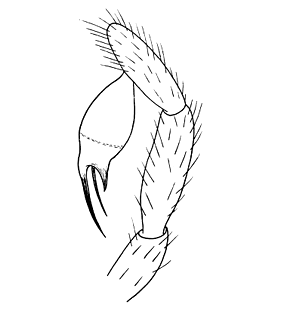Folkia pauciaculeata (Fage, 1943)
Description
Male
Very similar to F. inermis. Eyes extremely reduced. Leg spination: leg I and II spineless, except femur with 5 spines, patella III and IV with one spine, femur III with 4 spines, femur IV with 5 spines, posterior tibia and metatarsus with numerous spines.
Body length male: 4.5 mmFemale
Unknown.
Additional information
Only one male specimen known. In cave.
Troglobiont species (Mammola et al., 2022)
Distribution
Distribution List
"No references" does not mean that the species does not occur in this country, but that we have not yet inserted the reference for it. We are working on it.
References
Deeleman-Reinhold C L (1993) The genus Rhode and the harpacteine genera Stalagtia, Folkia, Minotauria, and Kaemis (Araneae, Dysderidae) of Yugoslavia and Crete, with remarks on the genus Harpactea. Revue Arachnologique 10: 105-135 ![]()
Deltshev C D (2008b) Faunistic diversity and zoogeography of cave-dwelling spiders on the Balkan Peninsula. p. 327-348. In: Makarov S E & Dimitrijevic R N (Eds): Advances in arachnology and developmental biology. Papers dedicated to Prof. Dr. Božidar Curcic. Monographs 12. 517 pp. ![]()
Katušić L (unpubl.) .
Kratochvíl J (1970) Cavernicole Dysderae. Přírodovědné práce ústavů Československé Akademie Věd v Brně (N.S.) 4: 1-62 ![]()
Le Peru B (2011) The spiders of Europe, a synthesis of data: Volume 1 Atypidae to Theridiidae. Mémoires de la Société Linnéenne de Lyon 2: 1-522 ![]()
Mammola S, Pavlek M, Huber B A, Ballarin F, Tolve M, Čupić I, Hesselberg T, Lunghi E, Mouron S, Graco-Roza C, Cardoso P (2022) A trait database and updated checklist for European subterranean spiders. Scientific Data 9(236): 1-13 ![]()
WSC (2025) World Spider Catalog. Version 26. Natural History Museum Bern, online at http://wsc.nmbe.ch (28.2.2025) doi: 10.24436/2 ![]()

